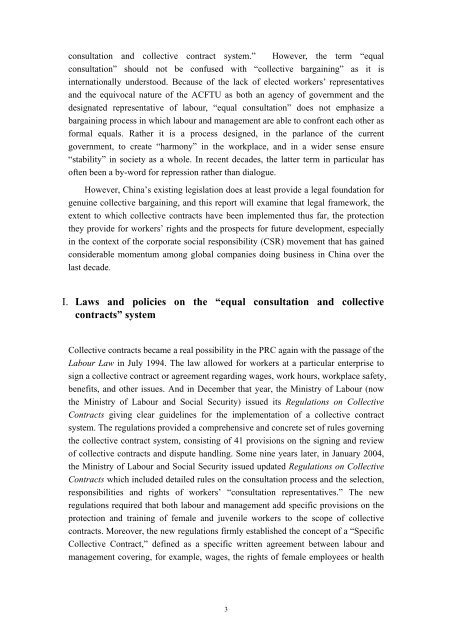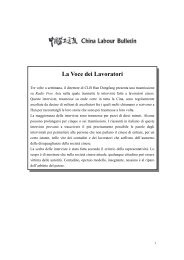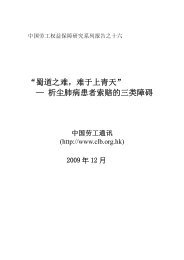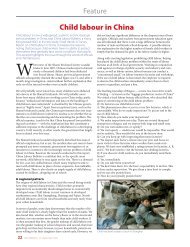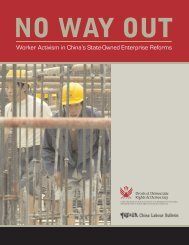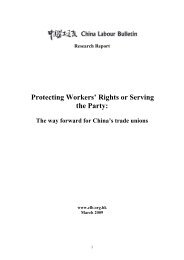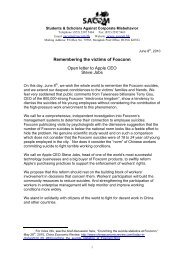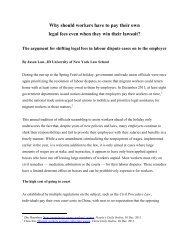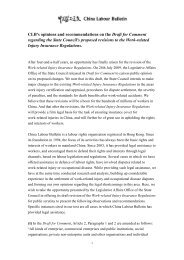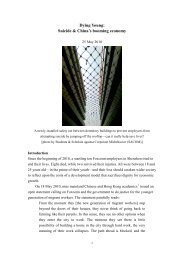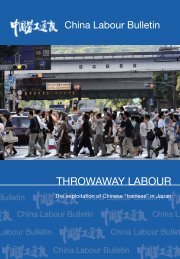here - China Labour Bulletin
here - China Labour Bulletin
here - China Labour Bulletin
You also want an ePaper? Increase the reach of your titles
YUMPU automatically turns print PDFs into web optimized ePapers that Google loves.
consultation and collective contract system.” However, the term “equal<br />
consultation” should not be confused with “collective bargaining” as it is<br />
internationally understood. Because of the lack of elected workers’ representatives<br />
and the equivocal nature of the ACFTU as both an agency of government and the<br />
designated representative of labour, “equal consultation” does not emphasize a<br />
bargaining process in which labour and management are able to confront each other as<br />
formal equals. Rather it is a process designed, in the parlance of the current<br />
government, to create “harmony” in the workplace, and in a wider sense ensure<br />
“stability” in society as a whole. In recent decades, the latter term in particular has<br />
often been a by-word for repression rather than dialogue.<br />
However, <strong>China</strong>’s existing legislation does at least provide a legal foundation for<br />
genuine collective bargaining, and this report will examine that legal framework, the<br />
extent to which collective contracts have been implemented thus far, the protection<br />
they provide for workers’ rights and the prospects for future development, especially<br />
in the context of the corporate social responsibility (CSR) movement that has gained<br />
considerable momentum among global companies doing business in <strong>China</strong> over the<br />
last decade.<br />
I. Laws and policies on the “equal consultation and collective<br />
contracts” system<br />
Collective contracts became a real possibility in the PRC again with the passage of the<br />
<strong>Labour</strong> Law in July 1994. The law allowed for workers at a particular enterprise to<br />
sign a collective contract or agreement regarding wages, work hours, workplace safety,<br />
benefits, and other issues. And in December that year, the Ministry of <strong>Labour</strong> (now<br />
the Ministry of <strong>Labour</strong> and Social Security) issued its Regulations on Collective<br />
Contracts giving clear guidelines for the implementation of a collective contract<br />
system. The regulations provided a comprehensive and concrete set of rules governing<br />
the collective contract system, consisting of 41 provisions on the signing and review<br />
of collective contracts and dispute handling. Some nine years later, in January 2004,<br />
the Ministry of <strong>Labour</strong> and Social Security issued updated Regulations on Collective<br />
Contracts which included detailed rules on the consultation process and the selection,<br />
responsibilities and rights of workers’ “consultation representatives.” The new<br />
regulations required that both labour and management add specific provisions on the<br />
protection and training of female and juvenile workers to the scope of collective<br />
contracts. Moreover, the new regulations firmly established the concept of a “Specific<br />
Collective Contract,” defined as a specific written agreement between labour and<br />
management covering, for example, wages, the rights of female employees or health<br />
3


